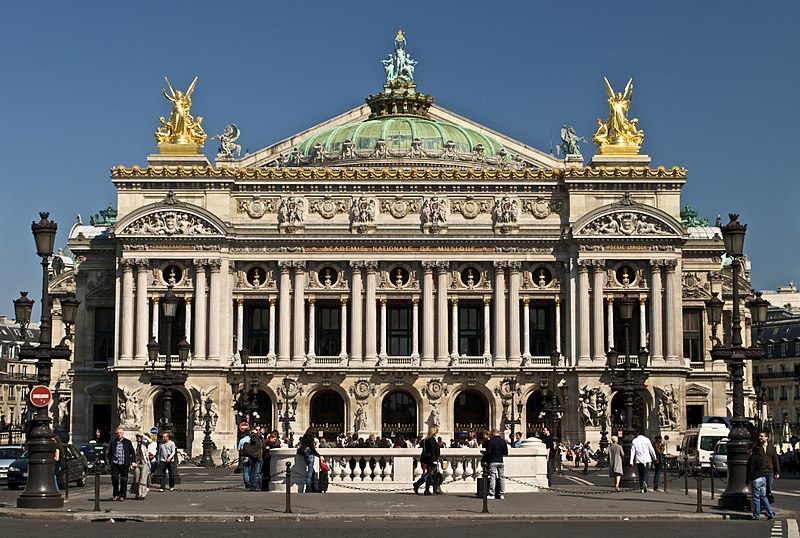The Paris Opera House │Palais Garnier
Place de l’Opéra, 75009 Paris. 8 Rue Scribe, 75009 Paris. Phone: +33 1 71 25 24 23

The Palais Garnier is a 1,979-seat opera house, which was built from 1861 to 1875 for the Paris Opera. It was called the Salle des Capucines, because of its location on the Boulevard des Capucines in the 9th arrondissement of Paris, but soon became known as the Palais Garnier, in recognition of its opulence and its architect, Charles Garnier. The theatre is also often referred to as the Opéra Garnier (French About this sound (help·info)) and historically was known as the Opéra de Paris or simply the Opéra, as it was the primary home of the Paris Opera and its associated Paris Opera Ballet until 1989, when the Opéra Bastille opened at the Place de la Bastille.The Paris Opera now mainly uses the Palais Garnier for ballet.
The Palais Garnier has been called “probably the most famous opera house in the world, a symbol of Paris like Notre Dame Cathedral, the Louvre, or the Sacré Coeur Basilica.” This is at least partly due to its use as the setting for Gaston Leroux’s 1910 novel The Phantom of the Opera and, especially, the novel’s subsequent adaptations in films and the popular 1986 musical. Another contributing factor is that among the buildings constructed in Paris during the Second Empire, besides being the most expensive, it has been described as the only one that is “unquestionably a masterpiece of the first rank.” This opinion is far from unanimous however: the 20th-century French architect Le Corbusier once described it as “a lying art” and contended that the “Garnier movement is a décor of the grave”.
The Palais Garnier also houses the Bibliothèque-Musée de l’Opéra de Paris (Paris Opera Library-Museum), although the Library-Museum is no longer managed by the Opera and is part of the Bibliothèque Nationale de France. The museum is included in unaccompanied tours of the Palais Garnier.
Source : wikipedia
Looking for interesting things to do in Paris? Visit one of the most popular museums in the city – the Grand Palais, otherwise known as the Grand Palais des Champs-Élysées. But, before you book your tickets, you might like to know a bit more about the Grand Palais.
This “palace” is a large historic complex, adjacent to the famous Champs Elysees, and as of today, it is home to a museum complex, a national gallery and an event hall. Something not everyone knows, is that it served as a military hospital during World War I and employed local artists to make molds for soldiers to be used as artificial limbs!
GET TO KNOW THE GRAND PALAIS IN PARIS
The Grand Palais is situated in the 8th arrondissement of Paris and built in Beaux-Art style architecture. It is considered to be the largest iron and glass structure in the world, with 9000 tons of steel and 15 thousand square meter of glass. It was built for the Universal Exposition of 1900, together with the adjacent Petit Palais and the bridge Pont Alexandre III. It hosts very popular exhibitions – so make sure you check what’s on while you’re in Paris!
The best way to see Paris is to plan in advance and that is done by booking a Paris city tour, which is free when you have the Paris Pass. With the Paris Pass you will be able to skip the endless lines, and see much more while spending less money! How is that possible? The Paris Pass, which you can buy a few weeks before you go on your vacation already, gains you free entrance to over 60 of the most popular Paris tourist attractions!
Located not far from the Grand Palais is the famous Arc de Triomphe, at the Place Charles de Gaulle. If you hold the Paris Pass you can get on a hop on hop off bus and hop off next to the Arc, to see the wonderful sights and walk to the Palais to enjoy the art and the special building. Want to know more about Paris sightseeing? Watch the rest of our guides for tips, ideas and lots of information.
Source : vidtur.com
https://www.youtube.com/watch?v=r1C8_EVU-Ng
https://www.youtube.com/watch?v=MikByeuQhi4
Reviews
https://bit.ly/2yoiNfO
Opening hours, Prices and getting there : https://bit.ly/2Nym55A
Suggested duration : 1.5 hours


Rate this article